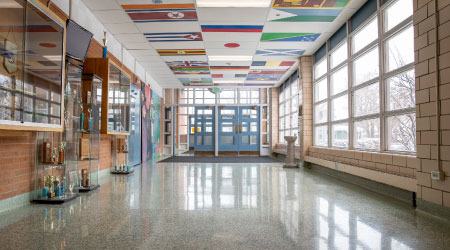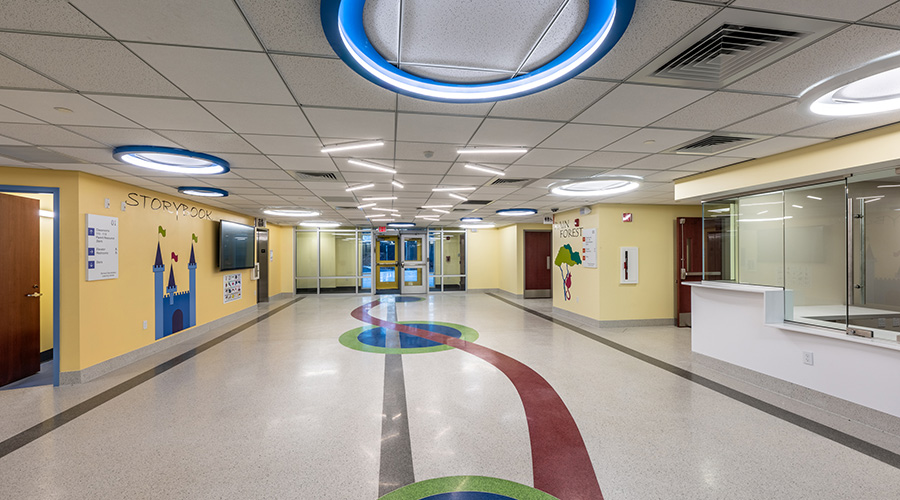A Three-Step Process Can Improve the Acoustics of Older Classrooms
As Betsey left her fourth period biology class, she noticed that she had another headache. Biology was her favorite subject, even though it required her to learn a lot of difficult terms, so why did this class seem to give her a headache? Was it the classroom? She had read that some new building materials could give off gasses, but this was an old classroom — with oak floors, plastered walls and a 12-foot-high plaster ceiling.
These physical elements of the classroom are actually the clues to the cause of Betsey’s headaches. The classroom has an indoor environmental quality problem: poor acoustics. Betsey is struggling to hear the pronunciation of complex terms through a fog of reverberation — the enemy of intelligibility.
Reverberation is the acoustic characteristic of an enclosed space that allows it to reinforce numerous reflections of the original sound, whether music or spoken word. It adds a pleasant effect to musical performance and is intentionally designed into music performance spaces. In a classroom or lecture hall, however, reverberation causes a listener to try to sub-consciously filter out the late-arriving reflected sound because it obscures the rest of a word or phrase. The ear and brain can decipher words through the haze, but it’s a physiologically taxing process leading to what has been historically called Listener Fatigue.
Although Betsey is intent on hearing every biological term, less interested students as well as those with hearing impairments may simply tune out.
To understand reverberation, visualize sound as though it were light. Sound is reflected and diffused through a room in much the same way light propagates. If sound traveled as fast as light, room acoustics would not be an issue. But since sound creeps along at about one foot per millisecond, its late reflections can arrive as much as 50 milliseconds after the original sound. These reflections collide with the direct sound, hurting intelligibility.
There is a direct, measurable correlation between intelligibility and reverberation. Acousticians measure reverberation of a space by determining how long it takes a sound impulse to decay 60 decibels (dB). The resultant measure, in seconds, is called RT60. Speech intelligibility can be predicted and measured as a function of reverberation and ambient noise.
School classrooms should have very low reverberation so articulation will be high. Although the new ANSI standard for room acoustics (S12.60) will benefit students in new or remodeled classrooms, many highly reverberant rooms will remain in use for years. But retrofitting an old wood and plaster room such as Betsey’s need not be too costly or difficult. A three-step progressive approach can control reverberation. The three steps involve treating three adjacent non-parallel surfaces of a room. That usually provides adequate control of reverberation. Parallel reflective surfaces support reverberation, so one of any two parallel surfaces should be treated to absorb sound and prevent the first bounce.
In rooms with plaster walls and hardwood floors, installing a drop ceiling of acoustic tiles at 9 to 10 feet will be a great start. This will break the ceiling-floor bounce. The ceiling tiles should display at least a 0.70 noise reduction coefficient (NRC).
The second step is to address the major acoustical offender: the back wall. Look into covering it, to 4 feet or higher, with pre-fabricated acoustic panels. These are typically 4-by-8-foot fabric-covered panels that are up to 2 inches thick.
When choosing acoustic panels, check with a sound system designer or an acoustic consultant to assure the panels will absorb a wide range of frequencies. Thicker panels are more effective at lower frequency reverberations, which may be more prominent in larger rooms. The way the panel is mounted is not critical, and the task may be performed by site staff. Although quite expensive, these panels have very predictable performance in reducing reverberation — an important consideration because applicable wall space may be limited.
If Betsey’s room is typical, one of the walls is made up of highly sound-reflective windows. For the final step, if the room is still not suitable after the first two steps, treat the opposing wall to the windows with the same acoustic panels. Even a 50 percent coverage from 4 feet to the ceiling will help considerably.
It’s important for school administrators and facility executives to be aware of the impact of classroom acoustics on learning. Students like Betsey probably won’t complain, but may just not be learning. It’s the responsibility of the school to provide a good learning environment, and the way to do that is by treating every classroom with the same acoustic integrity as a lecture hall. After all, important lectures occur in our classrooms every day.
Related Topics:











